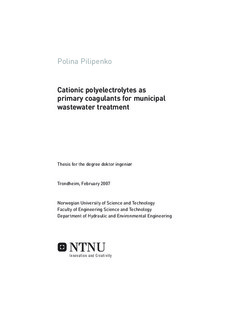| dc.contributor.author | Pilipenko, Polina | nb_NO |
| dc.date.accessioned | 2014-12-19T12:31:05Z | |
| dc.date.available | 2014-12-19T12:31:05Z | |
| dc.date.created | 2007-03-29 | nb_NO |
| dc.date.issued | 2007 | nb_NO |
| dc.identifier | 122239 | nb_NO |
| dc.identifier.isbn | 978-82-471-0332-6 | nb_NO |
| dc.identifier.uri | http://hdl.handle.net/11250/242066 | |
| dc.description.abstract | Chemical treatment is an established technique for wastewater purification used alone or as a pre-treatment before biological treatment. In spite of many advantages associated with it, the excessive sludge production makes this technology undesirable. Since the sludge produced during chemical treatment to a great extend is a precipitated metal phosphate/hydroxide, a complete or partial substitution of metal salt by a cationic polyelectrolyte may reduce the sludge production.
This dissertation investigates the potential of synthetic organic polyelectrolytes for removal of the particulate and colloid matter from municipal wastewater. In the first two chapters of the thesis the state of the art and the theoretical background are discussed. Chapter 3 presents the hypotheses proposed based on first two chapters. Chapter 4 describes the experimental design and procedures as well as analytical methods utilised. Chapter 5 is devoted to presentation and discussion of experimental results. In Chapter 6 the relationships between polymer structure, wastewater quality and treatment performance were established and models were proposed for prediction of polyelectrolyte dose and effluent quality. Chapter 7 consists of analysis of hypotheses and recommendations for polyelectrolyte selection. Finally, Chapter 8 concludes the work of this thesis.
The results of this thesis show that synthetic organic polyelectrolytes are effective coagulants for wastewater treatment. Both low and high molecular weight cationic polyelectrolytes can be used as solo primary coagulants and combined with low dosage inorganic coagulant. The optimum dosage of the low molecular weight polyelectrolyte (PDADMAC and P-Epi-DMA) is affected by the concentration of the particles, colloids and soluble organic matter. The specific dosage is significantly reduced with increasing concentration of the particulate matter. The soluble organic matter has a negative effect on the treatment efficiency and increases the optimum dosage. The residual polyelectrolyte concentration is a function of dosage for each polyelectrolyte tested. The molecular weight within one type of polyelectrolyte has little effect on the residual polyelectrolyte concentration. Very high molecular weight polyelectrolytes (PAM and PE) have lower residuals than the PDADMACs and P-Epi-DMA. The optimisation of the rapid mixing and flocculation procedures is crucial for minimising residual polymer concentration.
The process of wastewater coagulation-flocculation by the low molecular weight polyelectrolytes can be satisfactory described using a statistical multilinear regression model and mathematical regression model. The proposed models allow accurate prediction of the optimum dosage.
Addition of a low dosage of inorganic salt (i.e. Fe) significantly improves suspended particles and colloids removal by polymers. The combined coagulant removes the ortho-phosphates as well. Coagulation by such a dual coagulant is satisfactory described by the mathematical regression model. The treatment efficiency can be predicted with 90% accuracy.
The interaction between polyelectrolyte and dissolved organic matter lead to production of complexes, observed as colloidal particles. The size of the particle aggregates produced depends on the concentration ratio polyelectrolyte/dissolved organics organics. | nb_NO |
| dc.language | eng | nb_NO |
| dc.publisher | Fakultet for ingeniørvitenskap og teknologi | nb_NO |
| dc.relation.ispartofseries | Doktoravhandlinger ved NTNU, 1503-8181; 2007:16 | nb_NO |
| dc.title | Cationic Polyelectrolytes as Primary Coagulants for Municipal Wastewater Treatment | nb_NO |
| dc.type | Doctoral thesis | nb_NO |
| dc.contributor.department | Norges teknisk-naturvitenskapelige universitet, Fakultet for ingeniørvitenskap og teknologi, Institutt for vann- og miljøteknikk | nb_NO |
| dc.description.degree | dr.ing. | nb_NO |
| dc.description.degree | dr.ing. | en_GB |
